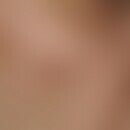Synonym(s)
DefinitionThis section has been translated automatically.
In the biological sense, an organism that is made up of genetically different cells that have emerged from a homogeneous zygote is referred to as a mosaic. In contrast, a chimera is formed from different cell populations. Cutaneous mosaics can be divided into 2 categories:
- Epigenetic mosaic: All cells have the same genome. The influence of certain regulatory genes results in functionally different cell clones. These functional mosaics are hereditary.
- Genetic mosaic: Two or more cell populations have different genomes.
Acquired mosaic dermatoses: Some acquired, usually diffusely distributed skin diseases can manifest themselves "suddenly" (in a phase of exacerbation) along the Blaschko lines (in atopic dermatitis, psoriasis vulgaris, dyskeratosis follicularis, lichen planus, circumscribed scleroderma, etc.). The cause is probably a mutated perceptive cell clone in which the underlying disease is realized.
ClinicThis section has been translated automatically.
Mosaics are particularly easy to identify in the skin, as the different cell systems are often visibly morphologically distinct from each other. Very diverse mosaic patterns can be distinguished in the skin:
- Type I: Skin manifestations along the Blaschko lines(ILVEN, Incontinentia pigmenti achromians (Ito); Incontinentia pigmenti, Bloch-Sulzberger type).
- Type II: Checkerboard pattern(nevus spilus, Becker nevus).
- Type III: Phylloid pattern(phylloid hypomelanosis).
- Type IV: Patchy pattern without midline border(melanocytic giant nevi).
- Type V: Lateralization pattern(CHILD syndrome).
- Twin spots: closely adjacent occurrence of two malformations in one and the same patient.
LiteratureThis section has been translated automatically.
- Happle R (2004) Cutaneous mosaics: patterns and molecular mechanisms. Dt Ärzteblatt 101: 1575-1580.
- Happle R (2016) The categories of cutaneous mosaicism: a proposed classification. Am J Med Genet A 170A: 452-459.
- Moog U et al (2020) Diseases caused by genetic mosaicism. Dtsch Ärztebl Int 117: 119-125.
- Peron A et al (2018) Genetics, genomics, and genotype-phenotype correlations of TSC: insights for clinical practice. Am J Med Genet C Semin Med Genet 178: 281-290.
- Rohlin A et al. (2009) Parallel sequencing used in detection of mosaic mutations: comparison with four diagnostic DNA screening techniques. Hum Mutat 30: 1012-1020













